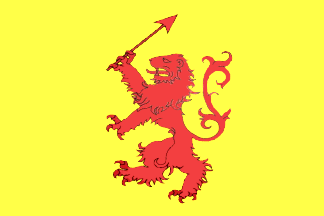

Last modified: 2025-01-04 by olivier touzeau
Keywords: labourd | basque country |
Links: FOTW homepage |
search |
disclaimer and copyright |
write us |
mirrors
Flag of Labourd - Image by Olivier Touzeau, 4 June 2022
See also:
Initially dependent on the Duke of Aquitaine, also King of England, Labourd became part of the royal domain in 1450. With Bayonne as its capital (Lapurdum in Latin), it roughly corresponds to the zone of influence of the ports on the seaboard of the northern Basque Country and in particular, that of the commercial port of Bayonne.
Just like the historical territories of the southern Basque Country in Spain (Alava, Biscay, Guipuzcoa and Navarre), the historical territories of the the northern Basque Country (Lower-Navarre, Labourd and Soule) had “regional forums" which represented the autonomy of these territories. These forums were abolished on the night of August 4, 1789, in the midst of the French revolutionary ferment. These regional assemblies, made up of delegates from each commune, excluded or limited the power of the privileged people of the time, namely the nobility, the nascent bourgeoisie and the clergy. During the division of France into departments, in 1789, proposals to create a Basque department, in particular by Dominique Garat, were not followed up and on March 4, 1790, the three provinces were grouped together with Béarn and with the Gascon lands of Bayonne and of Bidache and Soubestre to form the department of Basses-Pyrénées, now Pyrénées-Atlantiques.
Olivier Touzeau, 4 June 2022
The flag of Labourd s a banner of the dexter part of the arms, yellow with a red lion holding a harpoon dart.
See too Aingeru Astui's website.
Olivier Touzeau, 4 June 2022